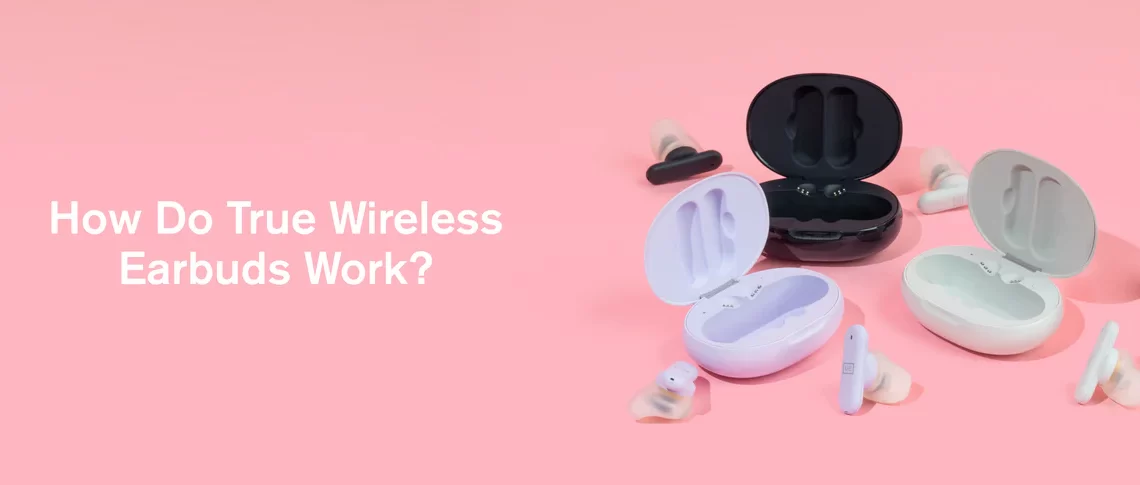Good news for lovers of both music and movement: true wireless earbuds use the latest Bluetooth technology to cut the cords—all of them—for those moments when cables really mess with your mojo.
In this article, we’ll examine the advanced wireless audio technology that makes true wireless listening possible and explain the difference between “wireless” and “true wireless” earbuds.
How Do True Wireless Earbuds Work?
True wireless earbuds replace the between-the-ear cable (used to send audio signals between the left and right sides of “wireless” earbuds) with an additional wireless connection. So that’s two wireless connections, total.
Besides just playing music, one earbud—the “primary” earbud, which can switch between the left or the right— takes the job of connecting to your phone and syncing to the other, now secondary, earbud. This is harder than it sounds.
All wireless audio signals have latency, which is the time delay of the wireless signal as it travels from your phone to your earbuds—a few milliseconds, at most.
And since there’s space between your ears, it takes time for the Bluetooth signal to travel from your phone to the primary earbud, then onward from the primary earbud to the secondary earbud, thus introducing the possibility of latency between your left and right ears.
The primary earbud works overtime to eliminate latency by calculating the time it takes for a wireless signal to travel from the primary to secondary earbuds. This measurement is called ping time. It then applies an audio delay (no more than a few milliseconds) so the left and right channels of your music, podcast, or phone call arrive in both ears at the same time, with perfect stereo sound.
Too much latency causes the left and right earbuds to be out-of-sync (an extremely disorienting musical experience). In crowded spaces like music festivals or public transit, the latency of a multitude of Bluetooth devices all trying to sync over the same airwaves at the same time can cause the signal to drop off entirely.
Coincidentally, if you notice the battery of one of your earbuds drains a little faster than the other, it’s likely because that earbud is pulling double-duty as the primary earbud.
What’s the Difference Between “Wireless” and “True Wireless” Earbuds?
When the first Bluetooth wireless earbuds arrived on the scene, we were amazed by their sound quality and convenience. However, we did have some small concerns.
Traditional “wireless” Bluetooth earbuds aren’t 100% wireless. While there’s no wire tethering you to your device—which is a huge improvement, especially for anyone on the move—it’s still not exactly a true wireless experience. But, still, it’s a massive improvement for everyone from crossfitters doing their kettle bells to desk workers making a quick run to refill their coffee. Better to have a wire between your ears than keep your phone on a three-foot leash to enjoy some tunes, right?
Though we appreciate the freedom of movement afforded by wireless earbuds, they can be uncomfortable to wear for long periods of time. The added weight of the behind-the-head cable, though slight, can be a little annoying over the course of a full day. It can also cause earbuds to fall out. Some manufacturers address this by adding an around-the-ear clip that holds earbuds in place, which some users find uncomfortable.
Also, cables are easily the most fragile part of any headphones. They break. They get dirty. Twisted. Tangled. That’s no good. When dust and dirt get onto your cable and inside the audio jacks of your wireless earbuds, it interrupts your music with static. Who’s trying to hear that?! Unless you can easily remove those cables, like you can with our CSX earphones, it can cause major issues with your devices.
Enter “true wireless” earbuds. True wireless earbuds connect to your phone and to each other via Bluetooth for a high-quality wireless listening experience that actually has, like, zero wires.
Benefits of True Wireless Earbuds
Besides the increased freedom of movement and total lack of tangled, dirty, or lost cables, true wireless earbuds have a host of additional benefits. They’re less likely to fall out, have fewer fragile components, and offer customizable tap controls over volume, next or previous track, plus more. Check out our article to learn more about all the benefits of true wireless earbuds.
Drawbacks of True Wireless Earbuds
There are two main—albeit minor—drawbacks to non-wired earbuds of any kind, wireless or true wireless: wireless interference and physical interference.
The first, wireless interference, occurs because Bluetooth operates in the FCC’s 2.4GHz wireless band, where it shares the airwaves with wi-fi routers, other wireless devices and, believe it or not, microwave ovens. Keeping your distance from the microwave while you reheat leftovers is pretty easy, but unfortunately there’s not much to be done about interference from competing wireless traffic, except trying again in an area with fewer competing wireless signals.
Second, physical (or cross-body) interference happens when objects in the environment obstruct the wireless signal headed for your earbuds. Bluetooth signal strength decreases as you move away from your phone and in rare situations, your body itself can block wireless signals. If this happens, simply moving your phone from your pants pocket to an above-the-waist shirt or jacket pocket can strengthen the connection enough to continue your podcast.
Try UE FITS Today
UE FITS are the world’s first custom-fit true wireless earbuds. Experience the unparalleled comfort of our fall-out proof tips and unmatched sound quality backed by decades of pro audio experience.







